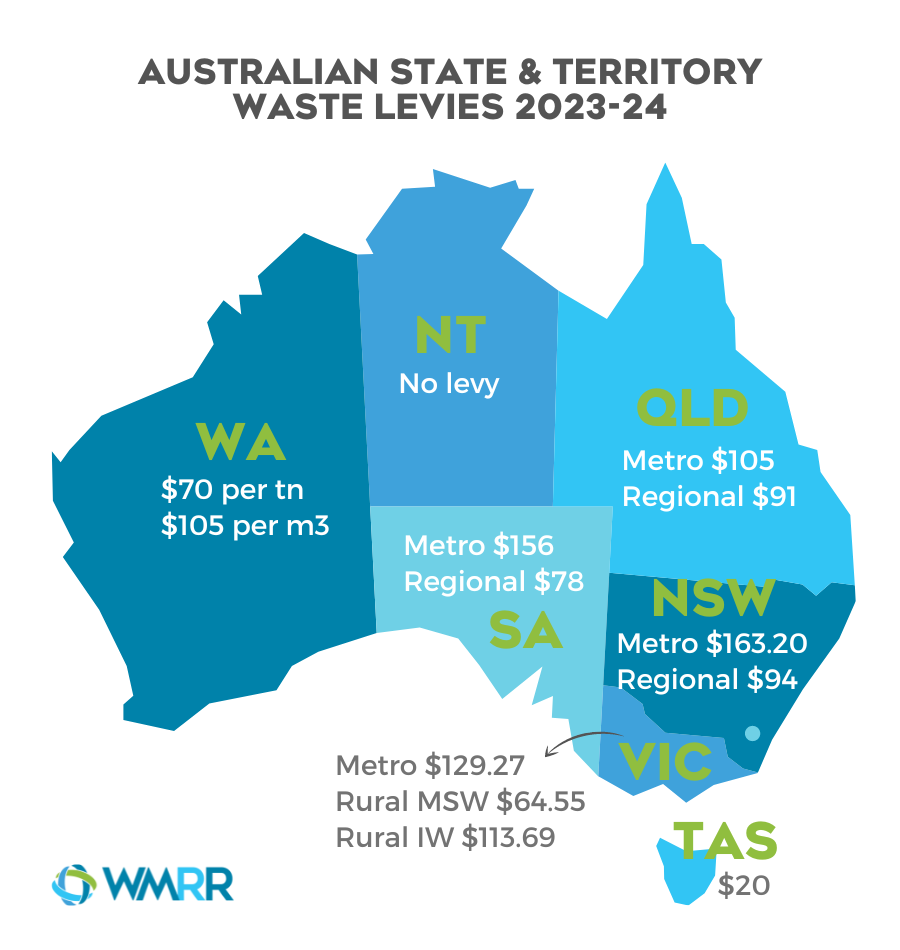You have probably never thought too far beyond what your waste actually costs, unless you’ve glanced at your Council rates charges or made a visit to the transfer station, aka The Tip, recently to dispose of your goods.
The reason I feel compelled to write about this is that not only being an afterthought of a cost borne to the user, the cost of our waste disposal varies significantly from state to state, metro vs regional. The good news is, there are schemes and measures in place to recover items and reprocess for recycling and reuse.
Waste levies - set by each state
A levy is charged per tonne of waste which enters a landfill site. It is designed to make landfilling the more expensive and least preferable option and recycling and resource recovery financially attractive. The levy fee is paid to the state.
The levy fee is broken up into metropolitan and regional rates plus a gate fee on top of that. There are many exemptions, classifications of waste and other charges which differ from state to state.
Source: Waste Management and Resource Recovery Association Australia website
In fact the definition of ‘waste’ also differs from one jurisdiction to another, making investment and progress to managing and minimising waste extremely difficult. To think about this further, when we mention the term ‘waste’ this essentially means ‘the end’, ‘a wasted item is no longer’ whereas other definitions may acknowledge the potential of that item to be repurposed, reused or recycled and referred to as secondary waste, rather than a resource.
Why is this all important?
As you can see, price varies significantly by each state. If a landfilling price is cheaper in the next state, guess where most of the waste will end up? This was the case until recently where Sydneysiders’ waste was being trucked and trained up north over the border where it was significantly cheaper to dump. Queensland has since introduced a reasonable and competitive levy and other restrictions to prevent this.
Waste and recycling boils down to economics as it would be a smart business decision to lower costs where possible. It also comes down to value: if a recyclable item doesn’t have a good market value price, unfortunately, it can be cheaper to send it to landfill.
Whilst on the topics of levies…
In October 2023, a levy for electric vehicles was challenged within the high court of Australia. The existing law of an excise tax for electric vehicle owners charged drivers for every km driven. This was found to be ‘unconstitutional because the states do not have the power to impose such excise taxes on consumption’ and the law has been scrapped for the state of Victoria. It is predicted that other states won't be far behind in wiping out this tax, which could also have flow on effects to other state imposed taxes, such as landfill levies.
If this was applied to landfills, could we see a more equitable situation when it comes to disposing of waste state to state? This will be an interesting space to watch in the coming months
Product stewardship
Product stewardship means that industry and businesses responsible for items on the market, need to take responsibility for the impact that item may create. This takes into account a whole-of-life approach from the design to manufacturing, selling and reclaiming or disposal to ensure a level of responsibility is achieved at each step. Product stewardship aims to have products managed responsibly to minimise environmental and human health.
There are a range of product stewardship schemes from voluntary to mandatory which take responsibility for priority items which industry support for the research and development of better design, manufacture and management of the products for the whole of life. Some of these schemes relate to specific items such as tyres, mattresses, televisions and computers etc. Further to this, the Minister for Environment has declared a priority list of items which require urgent product stewardship action.
Taking personal responsibility
When we purchase more items, our redundant/end of life stuff has to go somewhere. Buying and selling second hand is great however nothing lasts for ever.
For example, let’s say you upgraded your bed mattress. To dispose of your old mattress via a waste transfer station, this would incur a fee of anywhere between $20 - $70+ (depending on where you are located). Efforts within the stewardship scheme run by The Australian Bedding Stewardship Council, 60% of end of life mattresses are recycled however only 44-64% of the materials are actually recovered, with the remainder headed to landfill.
Consumers can choose to shop at retailers or choose brands which support existing product stewardship schemes. A list of these schemes can be found at the Product Stewardship of Excellence’s Product Stewardship Gateway.
As consumers, we need to take responsibility for the items we purchase and build in the cost of end of life such as disposal or rehoming options whilst states and industry need to manage the overall waste management of the big picture.




